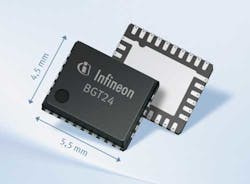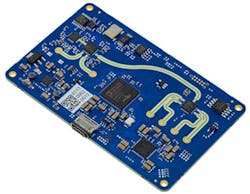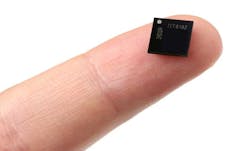Automotive Radar Paves the Way to Safer Roads
Download this article in PDF format.
What you'll learn:
- What types of circuits are used for ADAS radar transmitters, receivers, and transceivers?
- Radar ICs currently on the market.
- The various levels of integration for these ICs.
Radar systems are typically associated with military aircraft flying at high speed, but they have quickly made their way to civilian roadways and into commercial automobiles. Millimeter-wave (mmWave) radar systems are being integrated into new vehicles as part of advanced driver-assistance system (ADAS) electronic equipment for safer driving experiences. While fully autonomous, “self-driving” vehicles may still be a few years away, ADAS functions such as blind-spot detection and collision avoidance protect many drivers now. Low-power, high-frequency radar detection is vital to making it all happen, ultimately creating a safer driving experience.
Automotive radars are one of three essential sensor technologies contributing to ADAS capabilities, along with light detection and ranging (LiDAR) and camera-based sensors such as red-green-blue (RGB), infrared (IR), and near-IR cameras. Automotive radars function effectively at 24 GHz, although wider available bandwidths at 77 GHz are encouraging a growing number of frequency-modulated-continuous-wave (FMCW) radar integrated circuits (ICs) at those higher mmWave frequencies. Radar can differentiate between stationary and moving targets and detect multiple targets simultaneously, even calculating the relative velocity of a detected vehicle by its Doppler shifts.
Radar operates with consistent accuracy under all lighting and weather conditions, day and night, and across a wide range of temperatures. Sensor fusion by ADAS processors can use the data from the three types of sensors to create 3D images of detected targets. Developments in sensor fusion, notably leveraging radars at both frequency ranges, are clearing the way to producing 4D radar-based data for target range, angle, velocity, and elevation required for future autonomous-vehicle control.
Radar receivers, transmitters, and transceivers for ADAS are typically implemented as highly integrated monolithic microwave integrated circuits (MMICs) using high-frequency/high-speed semiconductor technologies such as silicon germanium (SiGe) or silicon (Si) BiCMOS. The MMICs usually support modular functionality, with separate MMICs for transmit and receive functions, or, as transceivers, with single or multiple transmit and receive channels per chip.
Whether at 24 or 77 GHz, ADAS radar circuit and system designers can specify major system function blocks like microprocessors, digital signal processing (DSP), and power supplies as packaged ICs to save space. A central ADAS processor performs sensor fusion by combining radar data with LiDAR and camera imaging data to create as much of a 360-deg. target detection field as possible (Fig. 1).
MMICs for ADAS mmWave radars are available for 24 and 77 GHz in short-range radars (SRRs) for detection to about 20 m, medium-range radars (MRRs) to about 60 m, and long-range radars (LRRs) to about 200 m or further. Current 24-GHz radar MMICs, which operate within the industrial, scientific, and medical (ISM) band from 24.00 to 24.25 GHz, have been used for non-automotive industrial and medical applications, including intruder detection in warehouses and heart-rate detectors, respectively.
Now, government regulators of frequency spectrum, including the U.S. Federal Communications Commission (FCC) and the European Telecommunications Standards Institute (ETSI), plan to free more bandwidth around 24 GHz for ultra-wideband (UWB) radars with increased target resolution compared to current 24-GHz ADAS radar MMICs.
With most drivers expecting new cars to include ADAS electronic solutions for increased safety, demand is ramping up for automotive mmWave radar solutions. More semiconductor suppliers, including some already making 24-GHz ADAS radar ICs, are developing radar ICs for the approximate 5-GHz bandwidth around 77 GHz (76 to 81 GHz) for SRR, MRR, and LRR ADAS applications.
Scanning Radar Solutions
Automotive radar ICs targeting 24-GHz ISM-band systems are highly integrated, fitting the functionality that once required a rack full of equipment into several chips. One example is the BGT24A family of ADAS radar transceiver and receiver ICs from Infineon Technologies.
Members of the BGT24A family include the BGT24ATR11, a 24-GHz radar transceiver with one transmit and one receive channel; the BGT24ATR12 with one transmit and two receive channels; the BGT24AR2 and BGT24AR4 with two and four receive channels, respectively; and the BGT24AT2 with two transmit channels, which can be added to either of the transceivers for enhanced situational awareness. The ICs come in VQFN packages (Fig. 2) for easy mounting on low-profile printed circuit boards (PCBs).
The BGT24ATR11 is a MMIC transceiver with single receive and transmit channels designed for use from 24.00 to 24.25 GHz. It’s AEC-Q100 qualified (stress testing that checks for failure mechanisms) for automotive applications, but has also proven its value in many industrial and medical applications. Based on 0.18-μm SiGe:C bipolar technology with an upper-frequency limit of 200 GHz, the MMIC centers around a low-noise, 24-GHz voltage-controlled oscillator (VCO). The VCO’s phase noise is typically −85 dBc/Hz offset 100 kHz from the carrier.
The MMIC transceiver contains a switchable prescaler with 1.5-GHz and 23-kHz outputs. It also provides a 24-GHz local-oscillator (LO) output signal at typically 0 dBm to drive additional functionality. The transmit section of the MMIC generates typical power of +9 dBm to an antenna; the output power can be controlled by 3 to 9 dB.
The transmitter features the fast on/off switching needed for radar use, at typically 500 ns, and controls spurious outputs to −30 dBm or less when in off mode. The homodyne-type receiver supports many different 24-GHz ADAS radar system configurations with a wide intermediate-frequency (IF) range of dc to 10 MHz. The 24-GHz radar transceiver is supplied in a compact RoHS-compliant VQFN package and consumes only 500 mW power from a single +3.3-V dc supply.
With one transmit and three single-ended receiver channels each with its own variable-gain amplifier (VGA), the STRADA431 from STMicroelectronics is an AEC-Q100-qualified 24-GHz ADAS transceiver also built around a low-noise 24-GHz VCO. Typical phase noise is −75 dBc/Hz offset 100 kHz from the carrier. Supplied in a 6- × 6-mm QFN package, it runs on a +3.3-V dc supply and is controlled with a four-pin SPI interface. The MMIC has on-board power and temperature sensors, and its single-channel transceiver provides +13-dBm differential output power at 24 GHz. It features switchable/selectable IF filters and is capable of as much as 60-dB receiver conversion gain.
Long-time IC supplier Analog Devices provides 24-GHz ICs for commercial and industrial security systems that also function for ADAS radars. As with many semiconductor suppliers, the company offers evaluation boards to simplify initial testing of the radar chips, too.
The ADF5901 24-GHz transmit IC and ADF5904 24-GHz receive IC along with the ADF4159 phase-locked-loop (PLL) IC are mounted on the EV-TINYRAD24G radar evaluation module and the EV-RADAR-MMIC2 evaluation board to explore how the ICs work together and/or with different mmWave antennas. The evaluation module (Fig. 3) is equipped with a phased-array antenna in a multiple-input, multiple-output (MIMO) configuration that allows antenna radiation patterns to be formed for transmit and receive functions using multiple small antenna elements in an array pattern.
These highly integrated devices achieve effective radar functions within small 5- × 5-mm LFCSF packages. The ADF5901, for example, provides dual 24-GHz radar transmit channels by means of an on-board power amplifier and 24-GHz VCO. The VCO also provides an LO signal for additional receiver functions. The IC contains an assortment of digital circuitry, such as an auxiliary analog-to-digital converter (ADC), as well as a temperature sensor and power-control circuitry for each transmit channel. A simple four-wire interface controls all of the on-chip registers.
Higher in Frequency
Because the available ISM bandwidth at 24 GHz is currently limited to 250 MHz, many circuit and system developers find the greater available bandwidth around 77 GHz (and the high resolution of the smaller wavelengths) attractive for ADAS radars. Many semiconductor processes used for 24-GHz ADAS radar chips support 77-GHz devices with similar transmitter, receiver, and transceiver architectures.
For example, STMicroelectronics fabricates its dual-band, 76- to 77-GHz and 77- to 81-GHz STRADA770M ADAS radar transceiver on SiGe BiCMOS. The tiny transceiver integrates four single-ended, 50-Ω receiver channels—each with high-resolution ADCs—with three single-ended, 50-Ω transmitter channels. The transmitter channels include chirp modulator and chirp sequencer, and the assortment of functions is contained within a single wafer-level BGA package measuring just 9 × 9 mm.
The STRADA770M radar transceiver includes an integrated low-phase-noise oscillator designed for use with 40- or 50-MHz crystal references. The typical phase noise is −95 dBc/Hz offset 1 MHz from a 77-GHz carrier. The transceiver provides transmit power of typically +13 dBm from 76 to 77 GHz and +10 dBm from 77 to 81 GHz. It achieves as much as 75-dB receiver conversion gain, adjustable over a 30-dB range in 10 3-dB steps. The densely packed IC features an on-board chirp sequencer and FMCW chirp modulator as well as a digital slave interface that can be set for SPI or I2C operation. The MMIC runs on a single +3.3-V dc supply.
The TEF8102 ADAS radar transceiver MMIC (Fig. 4) from NXP Semiconductors is fabricated on the firm’s 20-nm RF CMOS process. The packaged MMIC contains three transmit channels with binary control and output level stabilization as well as four receive channels; each receive channel has a dedicated 12-bit ADC. The on-board waveform generator achieves typical transmit power of +12 dBm from 76 to 78 GHz and +13 dBm from 78 to 81 GHz. The FMCW transceiver’s four receive channels, which provide serialized output data, benefit from the low noise of the waveform generator. Typical phase noise is −86 dBc/Hz or better when offset 1 MHz from any frequency from 76 to 81 GHz.
The radar transceiver supports SRR, MRR, and LRR applications from 76 to 81 GHz with chirp bandwidths of 0.5, 1.0, and 2.0 MHz/μs, respectively. It’s suited for autonomous emergency braking (AEB), adaptive cruise control (ACC), front cross-traffic alert (FCTA), rear cross-traffic alert (RCTA), parking assist (PA), and blind-spot detection (BSD). The transceiver provides the 4D radar data required for ADAS vehicles.
Four of the TEF8102 radar transceiver MMICs can provide enough data for full 360-deg. coverage. The device fits within a 7.5- × 7.5-mm embedded wafer-level ball-grid-array (eWLB) package and can be supplied on a test board (model TEF8102 evaluation board) for ease of system development.
The AWR1243 single-chip FMCW radar transceiver from Texas Instruments features three single-ended transmit and four single-ended receive channels covering 76 to 81 GHz. The firm offers two versions of the device: For model AWR1243, two of the three transmit channels can be operated simultaneously, and for model AWR1243P, all three transmit channels can be used simultaneously.
The radar MMIC is fabricated with a 45-nm RF CMOS process with low power consumption and the AEC-Q100-qualified transceiver can accommodate both +3.3- and +1.8-V dc supplies. The foundation of the MMIC is an on-board fractional-N PLL frequency synthesizer that commands precise chirp generation and synchronization.
The AWR1243’s waveform generator exhibits low typical phase noise of −95 dBc/Hz when offset 1 MHz from 76- to 77-GHz carriers, and −93 dBc/Hz when offset 1 MHz from 77- to 81-GHz carriers. The typical transmit output power is +12 dBm while the typical receiver conversion gain is 48 dB, with a 24-dB control range that’s adjustable in 2-dB steps.
The 77-GHz radar transceiver is designed for use with an external 40-MHz clock source. It features built-in temperature and power monitoring as well as built-in self-calibration across frequency and temperature. The transceiver comes in a flip-chip ball-grid-array (BGA) type package measuring 10.4 × 10.4 mm. By performing simple programming changes, the transceiver can be used for all three types of main automotive application types (SRR, MRR, and LRR) at frequencies from 76 to 81 GHz.
Some of the 24-GHz FMCW radar MMIC suppliers are also developing radar MMICs for 77-GHz ADAS applications, such as Analog Devices and Infineon. For example, as with its 24-GHz devices, Infineon fabricates its 77-GHz devices on a SiGe process. While still in preproduction, these radar MMICs are slated for the company’s RASIC product line. They include the RXS816xPL transceiver with three transmit and four receive channels and the RXS8156PLA transceiver with two transmit and four receive channels. Both 77-GHz radar MMICs will be available in eWLB packages.




